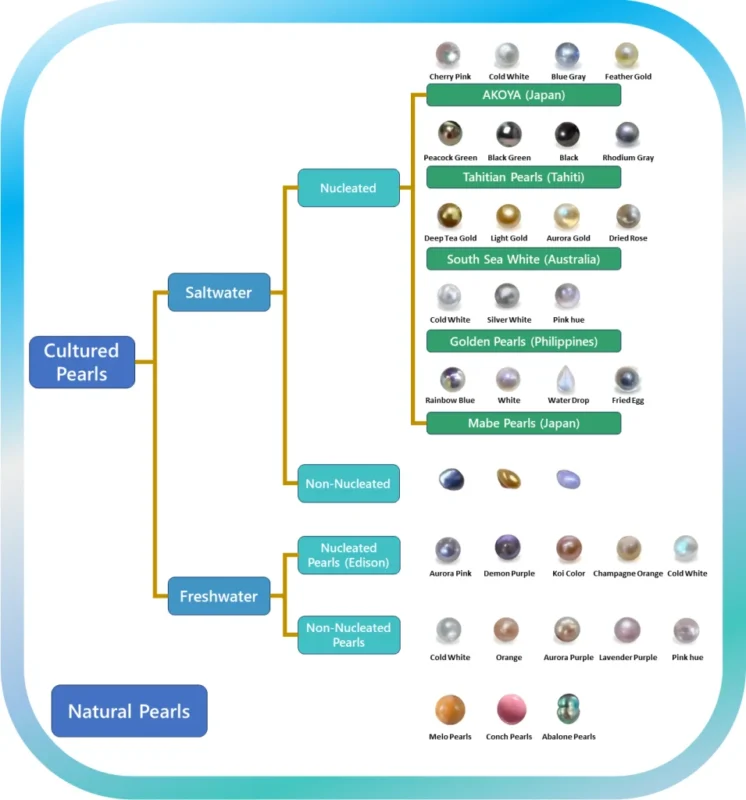Understanding the Different Types of Pearls: A Comprehensive Guide

Pearls have captivated people for centuries with their natural beauty and elegance. Whether you’re a jewelry enthusiast, a designer, or someone looking to buy pearls, understanding the different types of pearls can enhance your appreciation and knowledge. So, let’s dive into the fascinating world of pearls and explore their various classifications.
Classification Based on Origin
Freshwater Pearls
Freshwater pearls are typically found in rivers, lakes, and ponds, with the majority being sourced from China, the United States, and Japan. These pearls are known for their variety of shapes and colors and are generally smaller in size compared to their saltwater counterparts. Notably, freshwater pearls are usually nucleus-free, meaning they are composed entirely of nacre, giving them a unique lustrous quality. The city of Zhuji in China is renowned for its freshwater pearls, often called the “Pearl City.”
Akoya Pearls
Akoya pearls are renowned for their high luster and perfect round shape. Sourced primarily from Japan and China, these pearls are typically white or cream-colored, making them a classic choice for traditional pearl jewelry. Akoya pearls are typically nucleated, containing a bead nucleus surrounded by layers of nacre, which contributes to their consistent shape and high luster.
South Sea Pearls
South Sea pearls are the largest and rarest type of pearls, primarily found in the waters of Australia, Indonesia, and the Philippines. They range in color from white to gold and are highly valued for their size and quality. These pearls are also nucleated and are known for their thick nacre, which gives them a unique, satiny appearance. The waters off Broome in Western Australia are particularly famous for producing high-quality South Sea pearls.
Tahitian Pearls
Tahitian pearls, also known as black pearls, are naturally dark-colored and sourced from French Polynesia. These pearls come in a variety of colors, including black, green, blue, and purple, and are prized for their exotic appearance. Tahitian pearls are nucleated and are primarily farmed in the warm lagoons of the Tuamotu Archipelago and Gambier Islands.

Classification by Shape
Now that we’ve covered the origins of pearls, let’s move on to the fun part: the different shapes of pearls! The shape of a pearl adds to its unique charm and can significantly influence its use in jewelry.
Round Pearls
Round pearls are the most valued for their perfect symmetry and are often used in high-end jewelry. Their classic and timeless appeal makes them a favorite among pearl lovers.
Baroque Pearls
Baroque pearls have irregular and unique shapes, offering a distinct and individualistic appeal. Each baroque pearl is a one-of-a-kind piece, perfect for creating standout jewelry designs.
Other Shapes
- Rice Pearls: Elongated shape, resembling grains of rice.
- Potato Shape Pearls: Oval with delightful irregularities, adding character.
- Biwa Shape Pearls: Elongated and irregular, often sourced from Lake Biwa in Japan.
- Keshi Pearls: Small, free-form shapes, known for their luster. These are typically nucleus-free and are a by-product of the pearl culturing process.
- Coin Pearls: Flat and round, resembling coins.
- Button Pearls: Flat on one side and rounded on the other, perfect for earrings.
- Drop Pearls: Tear-drop shape, ideal for pendants and earrings.
Classification by Color
Pearls come in a range of colors, from the classic white and cream to black, pink, and golden. The color of a pearl is influenced by the type of mollusk, water conditions, and environmental factors. Each color has its own charm and can be chosen based on personal preference and style.
Pearl Size and Quality Indicators
Pearl sizes vary depending on their type and origin. Freshwater pearls typically range from 2mm to 10mm, while South Sea pearls can go up to 20mm. Quality indicators include luster, surface quality, and nacre thickness, which all contribute to the pearl’s overall value and beauty.
Conclusion
Understanding the different types of pearls enhances your appreciation for these natural treasures. From their origins in freshwater and saltwater environments to their diverse shapes and colors, each pearl type offers its own unique beauty. So the next time you look at a pearl, you’ll know just what makes it so special!
